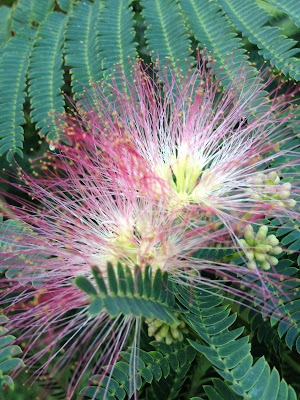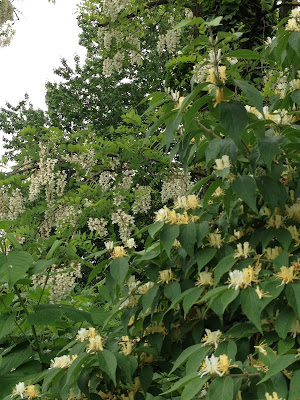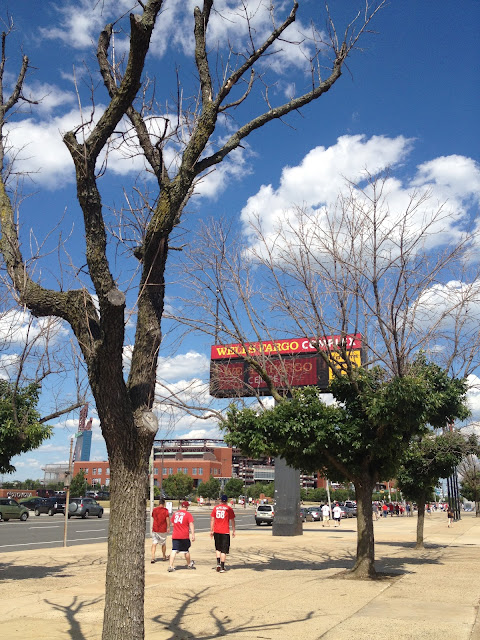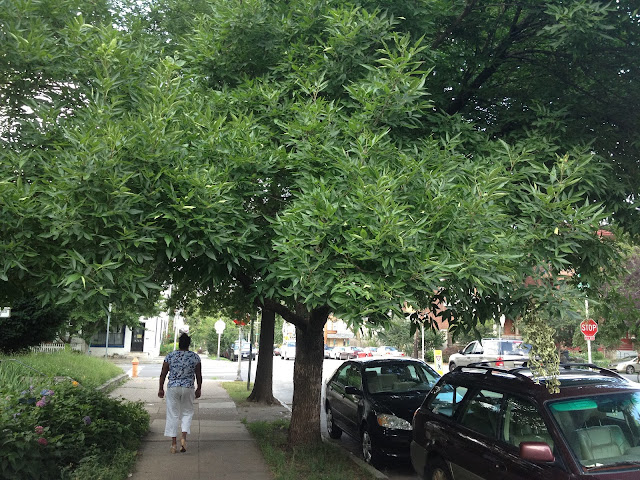An average weekday in June, sun setting
at 9:00pm, a quiet night at home, waiting for the rice to cool off, waiting for
the thunderstorm to break, waiting for Cliff Lee’s first win, just sitting around waiting for the
phone to ring, ladies…and I make the heart-breaking mistake of delving into the
photo archives to look at tree-pictures I never posted.
What happened?
There are just too many trees and not
enough time.
Out there on the mean streets, I always
end up running into trees that don’t quite fit into my planned posts.
I mean, I’ve missed a lot of great
trees.
The yellowwood and the black
locust?
Never got around to writing about that deep-ridged bark. Never got around to describing their brief spell of dangling flowers in mid-spring, though I have loads of pictures.
Honey-suckle and fringe trees?
 Yeah, I missed that boat too…although even
their pretty pictures can’t capture the spring breezes that always belied their
presence, wafts of honey out of the corner of your eye.
Yeah, I missed that boat too…although even
their pretty pictures can’t capture the spring breezes that always belied their
presence, wafts of honey out of the corner of your eye.
The horse chestnut? Now, that’s a big regret.
What a spectacular miss. It’s got everything I’m looking for in a tree. Droopy branches. Big-fisted, tear-drop leaves. Bright steeples of spring flowers just popping out of the green.
What happened, Jon Spruce? I was busy, horse chesnut. Busy and lazy.
Well, I won’t make the same mistake this
time. Here are three quick sketches of
three notable trees…trees I just can’t watch pass by.
If you go down to the Citizens Bank
ballpark to catch a Phillies game, walk down the Lincoln Financial Field side
of Pattison Avenue. There, you will see
a stand of ash trees.
This is no coincidence. Someone knew exactly what they were
doing. Someone knows their trees.
The ash tree is the premier wood for
sports equipment. It’s used for pallets
and tool handles and it’s used for musical instruments and it was even used in
early airplanes and automobiles but ash wood will always be known for its use
in sporting equipment: hockey sticks, lacrosse paddles, tennis raquets and that
big, bad peacemaker itself, the Wonderboy of legends, the Louisville Slugger.
In fact, the company Hillerich &
Bradsby, the makers of the Louisville Slugger, own 7500 acres of timberland on
the Pennsylvania-New York border, used to harvest the wood necessary to
make all those bats. “The best white ash
comes from parts of Pennsylvania, New York and several other northeastern
states,” their website says.
Fifty-percent of their bats are made
from ash wood. The other fifty-percent
is maple but maple bats didn’t become popular in the big leagues until the
nineties.
According to woodsmiths, it has the
perfect ratio of weight to strength. “Ash
has just the proper amount of tensile strength and resiliency required,” the
Louisville Slugger website states. “These
properties, in the finished bat, transmit power or drive.”
In baseball parlance, we call it the home run thwack.
It’s too bad, then, that this stand of
ash trees is doing so poorly. They look
wretched, sickly, dying.
Such a missed opportunity.
This is the perfect place for a shady
stand of healthy ash trees. It would be
an honorable, rightful monument for both the sport and the tree and just look
at them. Just look at them.
For comparison, here is a picture of a healthy ash tree.
I’m going to make the uneducated guess that the Citizens Bank ash trees are suffering from drought, but there is a bigger danger now to all of these trees, whether they are healthy or not.
Citybillies, meet your new nemesis: the emerald ash borer.
I’m going to make the uneducated guess that the Citizens Bank ash trees are suffering from drought, but there is a bigger danger now to all of these trees, whether they are healthy or not.
Citybillies, meet your new nemesis: the emerald ash borer.
This persistent little bugger is
currently destroying the entire northeastern ash population. From a recent
article in the Inquirer, March 2012:
A small, glitter-green insect that has killed more
than 50 million ash trees in the Midwest and beyond has arrived in the
Philadelphia region.
Officials had both dreaded and expected it - just
not this soon.
"This is pretty much
going to hammer ash trees in Southeastern Pennsylvania almost into
oblivion," said Scott Guiser, an educator at Pennsylvania State
University's extension service in Bucks County.
Carl Schulze, director of the division of plant industry in the N.J. Department of Agriculture, figured it was inevitable.
"We're sort of resigned to the march of
this."
In another article that appeared around the same time, the Pennsylvania Department of Forestry offers this dire statement: expect nearly all of the ash trees in the Philadelphia area to die eventually now that a Southeastern Pennsylvania infestation has been discovered.
So the golden age of ash baseball bats and the classic Louisville Slugger is slowly, sadly coming to an end.
Like all things, it might cycle back to its former dominance but, according to the experts, the northeastern ash tree extinction will most likely happen within our short lifetimes. With all these doomsday predictions, and with the current state of the Phillies line-up, we’re no more likely to see the ash population prosper again than we are to see another World Series championship parade down Broad Street.
These sickly, straggly ash trees outside Citizens Bank now have a more prescient, prophetic look to them. Enjoy them, even in this state, while you can, citybillies.
GOLDEN
RAIN TREE
There’s an interesting tree outside my
friend’s house on Kingsessing Street in between 47th and 48th
streets in West Philly. I've passed it by many times but it took the summer flowers out in bloom to catch my notice.


This is the golden rain tree, Koelreuteria paniculata, its poetic name a reference to those drizzly sprays of small, yellow flowers.
I snapped a few pictures of that golden
rain tree because, one, you don’t see it very often and, two, it’s always
interesting to see trees that flower later in the summer. It’s a special kind of tree that holds its
flowers until after it leafs out.
I didn’t think too much of the golden
rain tree again, until I walked by the new Barnes Museum on the Ben Franklin
Parkway. Ringing its parking lot? Golden rain trees. Lots of them.


It’s a tree native to Asia, especially China and Korea, planted here as an ornamental. Some of these trees even have their fruit out: small, papery capsules that end up hanging on all winter long.
Again, I have the feeling these trees
were planted with a specific purpose, so that, even in the summer, there’s some sort
of tree activity happening on the grounds.
In other words, they are meant to be hunted down in late June, just like
this.
I found another interesting tree in a
corner of the museum grounds.
This is a cryptomeria, a member of the cypress family. It is the national tree of Japan, resembling
a redwood or a sequoia. In its native
land, it can grow over 200 feet tall and 13 feet in diameter.
This is an exciting tree to find. It has huge potential to someday be a great, notable tree here in Philadelphia. I'll be keeping my eye on it. I predict that this tree in this corner of the museum will one day will be an extraordinary, stunning sight, a towering spire between the public library and the new Barnes Museum.
This cryptomeria will someday be a tourist destination by its own right.
This is an exciting tree to find. It has huge potential to someday be a great, notable tree here in Philadelphia. I'll be keeping my eye on it. I predict that this tree in this corner of the museum will one day will be an extraordinary, stunning sight, a towering spire between the public library and the new Barnes Museum.
This cryptomeria will someday be a tourist destination by its own right.
Maybe even one day, it might challenge
that big, red crane down the road for a place in the sky.
Sorry.
I got a thing for big cranes.
THE
NIGHT SLEEPER TREE
For the last week or so, I’ve been
seeing a lot of these pink flowering trees up and down the highways and, then, I
ran into some during my West Philly urban fruit picking escapades.
This time of year, they’re pretty easy
to find. Here’s one on Trinity Street,
between 49th and 50th streets.


This is called the silk tree, sometimes called mimosa, and sometimes it’s mislabeled and misnamed and mistaken for acacia or mesquite. Boy, I know how that feels.
But its real name is the silk tree, Albizia julibrissin, and it’s a
beaut. A few weeks ago, on this very
blog, I called it a weed tree. I really
did. If you drive into Jersey across the
Walt Whitman Bridge and start driving up 295 North, you’ll see this evasive
tree sneaking out of the woods and heading for the shoulders. I’ll still stand by my claim. It’s a weed tree, except during this time of
year.
This time of year, it’s a show-stopper
of a tree, a real head-turner.
I found three of them in a row on the
corner of 42nd and Spruce.
Native to ancient Persia and Korea, it’s
known for those pink, groovy flowers, technically and literally called
inflorescences.
They’re dazzling, a pom-pom of silky threads with wee orange specks right at the tips.


And look at those leaves: fine like a comb, lacy, complicated, one giant leaf made up of small leaflets.
They have a real rain-forest quality
about them. I like running my hand
through them.
As I was researching this tree, I
learned that its Persian name translates to night
sleeper because, according to legend, these leaves fold up at night.
What?
No way. This, I had to see for myself.
So I put the rice in the fridge, grabbed my hat and shoes and went back out to 42nd and
Spruce, in the dead of night, around nine-thirty.
Well, look at that.


I carefully snipped a leaf off, not something I recommend for amateur tree-hunters, but I wanted to see this in the clear light of the cabin.
Sure enough, the legend is true. The night sleeper tree, all tucked in.
Trees, man. Too many to see, too much to learn, never
enough time. Story of my life, ladies.























Good sshare
ReplyDelete